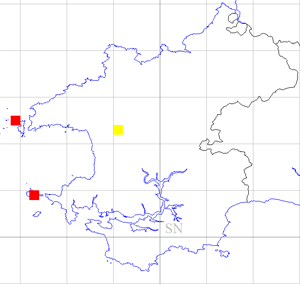Short-eared Owl - 2003-07
 Wednesday, May 9, 2012 at 6:25PM
Wednesday, May 9, 2012 at 6:25PM Short-eared Owls are very much birds of open rough grassland and heath, nesting on the ground usually under the shelter of heather, bracken or tall grasses. They will also breed in young forestry plantations. Areas with high populations of small mammal prey and a lack of disturbance, including disturbance from ground predators are key to their success.
Given these requirements, it is perhaps not really surprising that Short-eared Owls are a scarce breeding bird in Pembrokeshire and within Wales. Such “optimal” breeding habitat occurs mainly on the offshore islands.
Skomer is a long-established and regionally important breeding site for them, supporting up to five pairs between 1984 and 88, about 20% of the entire Welsh population at that time. In 1993 an unprecedented 12 pairs nested on the island. They also used to breed regularly on the commons of the St David’s peninsula where there are good stands of rough grassland and wet heath. The population appears to be fairly stable, compared with the 1984-88 period, though it fluctuates, probably depending on the density of vole populations.
During the 2003-07 atlas period between one and four pairs bred on Skomer and a single pair nested on Ramsey in 2005 for the first time since 1971. Breeding may also have occurred on Dowrog, where one was recorded carrying food in late May 2004 but breeding was not proven. Further sightings included a pair appearing to hold a territory on Dowrog in May 2006, but breeding did not occur.
Pellets analysed on Skomer have shown that although Short-eared Owls largely feed on young Rabbits and Skomer Voles, they may also take significant numbers of Storm Petrels, like the Little Owls breeding there. Fifty-five pellets examined in 2007 produced 18 Storm Petrels, whilst Storm Petrels formed 31% of prey recorded in 13 pellets in 2004.
Bob Haycock

Fieldwork 2003-07 (based on 490 tetrads)
Red = breeding confirmed = 2
Yellow = breeding possible = 1
Total tetrads in which registered = 3 (0.6%)
 PBBA 2003-7,
PBBA 2003-7,  RJH in
RJH in  Short-eared owl
Short-eared owl 

Reader Comments